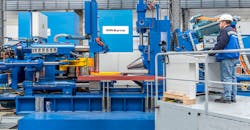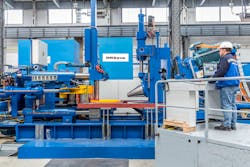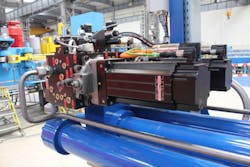Industrial Hydraulic Concept Offers Best of Both Worlds
The price of electricity for industrial customers has doubled since the year 2000. Since this trend is unlikely to change anytime soon, machine makers and operators must improve the energy efficiency of their systems. The most effective way to achieve this is to start with the drive technology—generally either an electrohydraulic or electromechanical drive, depending on the power class. Both technologies have system-specific advantages and disadvantages. But which concept is best suited for the respective application?
The electrohydrostatic drive combines the advantages of both technologies and eliminates all of the disadvantages. As the following application example shows, choosing an electrohydrostatic drive saves operating costs and boosts productivity, both during the installation phase and while operating.
Manufacturer Develops New Drive Concept
SMS group GmbH, a manufacturer of ring rolling mills, developed a new drive concept with Moog for its next generation of machines. SMS group’s legacy machines had a central hydraulics system with a large oil tank and elaborate pipework. These previous designs required machine operators to implement additional construction measures around the machine (e.g., extra rooms in the basement for housing the central hydraulic system). Consequently, installing and commissioning the hydraulic system, including pipework, was very time consuming and costly for the customer.
Ring rolling is a forming process for manufacturing metal rings. Operators can seamlessly produce a broad spectrum of rings with various diameters (up to several meters), wall thicknesses, and heights on a machine. The rings have numerous applications, such as flanges for machine and plant construction; ring-rolled gear blanks for gearbox manufacturing; turbine discs for aircraft engines; rings for compressors and gas turbines; and especially large bearing rings for construction machinery. To produce larger rings, factory managers normally use rolling machines with a hydraulic tool infeed. In these machines, at least five linear axes work simultaneously to shape the rings.
Ring rolling machines with a hydraulic tool infeed contain at least five EAS drives for the linear processing axes working simultaneously for shaping rings.
Assessing Existing Drives
Design engineers built the previous SMS group drive solution on a central hydraulic system with accumulators (which are not energy efficient, particularly in partial load operation). In the accumulator-assisted hydraulic system, the pumps work constantly under high pressure. A high-resolution, dynamic servohydraulic system was located on linear rolling axes. The servovalve controlled the power.
As a result, some considerable throttle losses occurred in the system, which had a detrimental effect on the overall efficiency of the machine. Rapid movements without force—and slow, high-resolution infeed movements under high forces with partially changing force directions—characterized the machine cycle. The control type changed from position to force control and vice versa. In spite of the flaws, the SMS group and Moog engineering team rated this concept as robust and overload-proof, with a high level of availability. The team decided to ensure these positive qualities carried over when implementing a concept for SMS group’s next-generation machine.
Combining Hydraulics with Electromechanics
The engineering team’s requirements analysis for an alternative drive concept included these core points:
- Phase out the complex central hydraulic system with its numerous connection elements (e.g., hoses and pipes).
- Ensure a simplified, shortened installation and quicker commissioning of the rolling machine on-site at the end customer.
- Eliminate the central hydraulic system to significantly reduce the noise level and any safety or environmental hazards.
These changes would make the machine considerably more energy efficient and productive.
With the results of the requirements analysis in hand, the SMS-Moog engineering team looked at using an electrohydrostatic actuation system (EAS), which combines the energy advantages of an electromechanical drive based on the power-on-demand principle with the advantages of hydraulics for robust power transmission, low cost, and high availability. The EAS design concept incorporates electric and hydraulic components in one system, including the servo-drive-controlled servomotor, the speed-controlled radial-piston pump in four-quadrant operation, and as a manifold and hydraulic cylinder. The cylinder velocity is proportional to the motor speed.
A Decentralized Drive Solution
SMS group preferred the EAS solution because extremely high forces (exceeding 1 MN) are applied and extreme impact loads can occur. This is the domain of hydraulic drives. The EAS can handle these forces in its hydrostatic gearbox. With the experts from Moog, SMS group chose the EAS concept and implemented this on a new machine type. To save space, the design engineers flanged the motor pump unit directly onto the manifold. The manifold contains all the necessary overload and logic functions, and the machine makers mounted it directly on the hydraulic cylinder. The servomotor, pump, manifold, and hydraulic cylinder all form a unit. The designers also reduced to a minimum the amount of pipework on the cylinder.
In addition, the design team integrated the EAS functional units directly on the machine axes. Because the pump can be switched in its displacement volume, rapid movements with high speed and work movements with low speed and high force are easy to implement. A common DC bus, which is powered by a regenerative power supply unit, electrically connects all servo drives.
The EAS drive combines the energy advantages of an electromechanical drive based on the power-on-demand principle with the advantages of hydraulics. It incorporates a closed-loop servomotor, radial-piston pump in four-quadrant operation, and a manifold and hydraulic cylinder.
Energy Consumption Reduced 40%
The possibilities for saving energy with the EAS concept are enormous: Compared with conventional ring rolling machines, the modified axes in this machine use up to 40% less energy. The connected power is significantly reduced. And the new machine design dispenses with all machine and foundation piping, so installing the machine is much easier. Because the new design reduces the quantity of oil from roughly 2,500 liters to about 200, it has a much smaller installation footprint than that of a large hydraulic unit. Since the machine uses far less hydraulic oil, the designers saved a substantial amount of resources and operating materials. Plus, they increased the machine’s productivity while making its operation considerably quieter.
Implementing an EAS concept is new for this field of mechanical engineering. Moog and SMS needed about eight months to develop and implement the machine concept. Working together, the engineers began by sizing the axes and continued collaborating closely around machine integration, functional safety, and commissioning and analyzing the machine’s performance. The SMS group and Moog’s work team observed the industry’s first EAS-driven rolling mill begin operation for its owner last fall.
The Electrohydrostatic Pump Close Up
Moog Inc. recently introduced its Electro-Hydrostatic Pump Unit (EPU) to help machine builders and end users derive the combined benefits of both hydraulic and electric actuation. The Moog EPU is at the heart of an electrohydrostatic actuation system and helps make the decentralized drive system possible. Doing so eliminates the need for a hydraulic power unit (HPU) and associated piping to reduce the overall machine footprint. The compact design of the EPU has it mounted directly onto a cylinder, thereby reducing space requirements on each motion axis even more.
Because they have fewer fluid connections, the self-contained units greatly reduce the potential for leaks. The clean, simple design also improves reliability, maintenance, and total cost of ownership compared to conventional units. The electrohydrostatic pump units can be used for a wide range of applications, such as metal forming, injection molding, die-casting, gas and steam turbines, and wind turbine pitch control.
“Our EPU is ideal for companies that want a standard, out-of-the-box product that can be easily integrated into their hydrostatic transmission or new machine designs,” said Dr. Achim Helbig, innovation manager at Moog. “It has a mounting pattern that allows direct mounting onto a cylinder via a manifold. This reduces plumbing time and costs, installation time, and maintenance work can be considerably simplified.”
Moog’s Electrohydrostatic Pump Unit combines the elements of a conventional hydraulic power unit into a lighter, more compact, modular assembly that can be mounted directly to a cylinder via a manifold. Its servomotor driven pump also makes the EPU substantially more energy efficient than conventional HPUs.
“Even short periods of machine downtime can translate into significant efficiency losses and cost,” said Robert Luong, marketing manager at Moog. “Our new electrohydrostatic pump unit is ideal for high-force machines and systems that need to be fail-safe. Most uses will reduce their total cost of ownership (TCO) due to the lower maintenance required and limited need for customization.”
The EPU is available either as a standalone product or as part of Moog’s Electro-hydrostatic Actuation System (EAS). The EAS combines the electrohydrostatic pump unit and any optional parts, such as drives, controllers, manifolds, and cylinders—all Moog components.
About the Author

Leaders relevant to this article:



